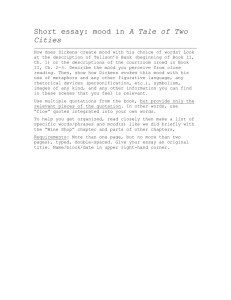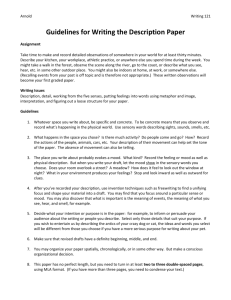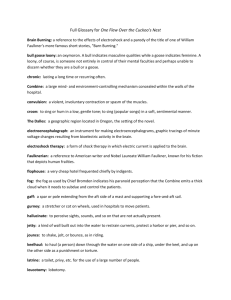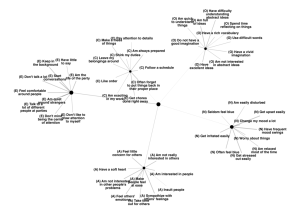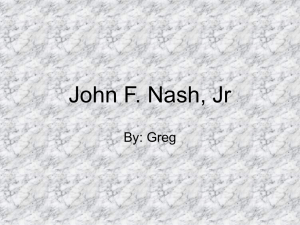Understanding the Mental Status Examination - The Hub
advertisement
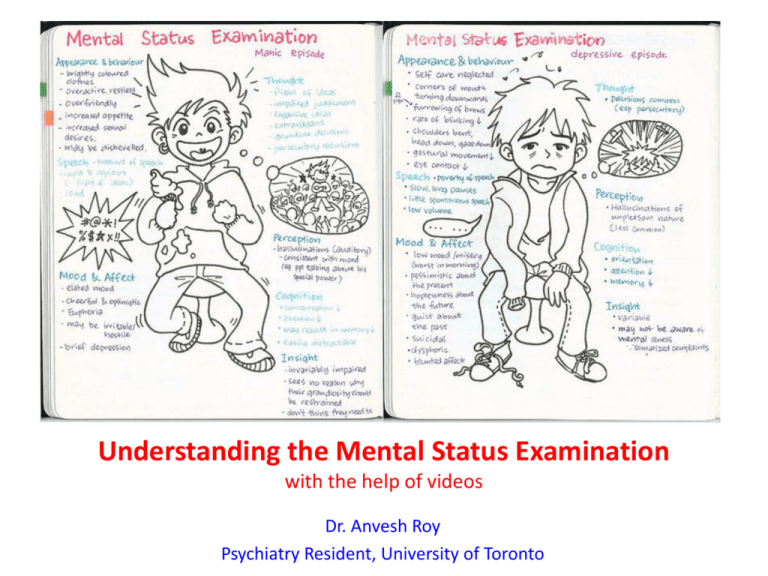
Understanding the Mental Status Examination with the help of videos Dr. Anvesh Roy Psychiatry Resident, University of Toronto Introduction • The mental status examination describes the sum total of the examiner’s observations and impressions of the psychiatric patient at the time of the interview. • Whereas the patient's history remains stable, the patient's mental status can change from day to day or hour to hour. • Even when a patient is mute, is incoherent, or refuses to answer questions, the clinician can obtain a wealth of information through careful observation. Outline for the Mental Status Examination • • • • • • Appearance Overt behavior Attitude Speech Mood and affect Thinking – a. Form – b. Content • • Perceptions Sensorium – – – – – – – • • a. Alertness b. Orientation (person, place, time) c. Concentration d. Memory (immediate, recent, long term) e. Calculations f. Fund of knowledge g. Abstract reasoning Insight Judgment Appearance • Examples of items in the appearance category include body type, posture, poise, clothes, grooming, hair, and nails. • Common terms used to describe appearance are healthy, sickly, ill at ease, looks older/younger than stated age, disheveled, childlike, and bizarre. • Signs of anxiety are noted: moist hands, perspiring forehead, tense posture and wide eyes. Appearance Example (from Psychosis video) • The pt. is a 23 y.o male who appears his age. There is poor grooming and personal hygiene evidenced by foul body odor and long unkempt hair. The pt. is wearing a worn T-Shirt with an odd symbol looking like a shield. This appears to be related to his delusions that he needs ‘antivirus’ protection from people who can access his mind. Attitude towards the Examiner • Cooperative, friendly, attentive, interested, frank, seductive, defensive, contemptuous, perplexed, apathetic, hostile, playful, ingratiating, evasive, or guarded; any number of other adjectives can be used. • Record the level of rapport established From the psychosis video: Note an apathetic, non cooperative, attitude towards examiner Speech Characteristics • Speech can be described in terms of its quantity, rate of production, and quality. • Such as: talkative, garrulous, voluble, taciturn, unspontaneous, or normally responsive to cues from the interviewer. There is alogia or poverty of speech in Schizophrenia • Speech can be rapid or slow, pressured (hard to interrupt the pt), hesitant, emotional, dramatic, monotonous, loud, whispered, slurred, staccato, or mumbled. • Speech impairments, such as stuttering, are included in this section. • Any unusual rhythms (termed dysprosody) or accent should be noted. Pressured Speech Monotonous speech, lacking normal inflections Behavior and Psychomotor Activity • This can include: • Mannerisms, tics, gestures, twitches, stereotyped behavior, echopraxia, hyperactivity, agitation, combativeness, flexibility, rigidity, gait, and agility. • Take note of movements which can result due to drug side effects eg. TD or EPS or tremors • Describe restlessness, wringing of hands, pacing, and other physical manifestations. • Note psychomotor retardation or generalized slowing of body movements. • Describe any aimless, purposeless activity. Psychomotor Agitation Mood • Mood is defined as a pervasive and sustained emotion that colors the person's perception of the world. • Usually means patient’s self reported mood • Does the patient remark voluntarily about feelings or whether it is necessary to ask the patient how he or she feels? • Statements about the patient's mood should include depth, intensity, duration, and fluctuations. • Common adjectives used to describe mood include depressed, despairing, irritable, anxious, angry, expansive, euphoric, empty, guilty, hopeless, futile, self-contemptuous, frightened, and perplexed. • Mood can be labile, fluctuating or alternating rapidly between extremes (e.g., laughing loudly and expansively one moment, tearful and despairing the next). Affect • Patient's present emotional responsiveness, inferred from the patient's facial expression, including the amount and the range of expressive behavior. • Quality: Dysphoric in depression, Euthymic (normal) or Elevated/Euphoric in mania, Flat in Schizophrenia or labile (all over the place), or irritable • Congruency: Affect may or may not be congruent with mood. • Range: Affect can be described as within normal range, constricted, blunted, or flat. • In the normal range of affect can be variation in facial expression, tone of voice, use of hands, and body movements. • When affect is constricted, the range and intensity of expression are reduced. In blunted affect, emotional expression is further reduced. • To diagnose flat affect, virtually no signs of affective expression should be present; the patient's voice should be monotonous and the face should be immobile. Note the patient's difficulty in initiating, sustaining, or terminating an emotional response. Dysphoric Affect (Video) Anxious Affect Elevated Affect Labile affect • Observe how at first the affect is elevated then becomes more irritable later on, therefore a labile affect Flat Affect Appropriateness of Affect • This means appropriateness of the patient's emotional responses in the context of the subject the patient is discussing. • Delusional patients who are describing a delusion of persecution should be angry or frightened about the experiences they believe are happening to them. • Inappropriate affect for a quality of response found in some schizophrenia patients, in which the patient's affect is incongruent with what the patient is saying (e.g., flattened affect when speaking about murderous impulses). Perception • Perceptual disturbances, such as hallucinations and illusions, can be experienced in reference to the self or the environment. • This can be sometimes inferred also when the patient clearly responds to internal stimuli (and can be described as such) • The sensory system involved (e.g., auditory, visual, taste, olfactory, or tactile) and the content of the illusion or the hallucinatory experience should be described. • Feelings of depersonalization and derealization (extreme feelings of detachment from the self or the environment) are also part of this section. Perception – responding to internal stimuli and having active auditory hallucinations Thought • Thought can be divided into process (or form) and content. • Process refers to the way in which a person puts together ideas and associations, the form in which a person thinks. • Process or form of thought can be logical and coherent or completely illogical and even incomprehensible. • Content refers to what a person is actually thinking about: ideas, beliefs, preoccupations, obsessions Thought Process • The patient may have either an overabundance or a poverty of ideas. • There may be rapid thinking, which, if carried to the extreme, is called a flight of ideas. • A patient may exhibit slow or hesitant thinking. • Thought can be vague or empty. – – – – – Do the patient's replies really answer the questions asked? Does the patient have the capacity for goal-directed thinking? Are the responses relevant or irrelevant? Is there a clear cause-and effect relation in the patient's explanations? Does the patient have loose associations (e.g., do the ideas expressed seem unrelated and idiosyncratically connected)? • Disturbances of thought continuity include statements that are: – tangential, circumstantial, rambling, evasive, or perseverative Formal Thought Disorders • • Circumstantiality : Overinclusion of trivial or irrelevant details that impede the sense of getting to the point. Tangentiality : In response to a question, the patient gives a reply that is appropriate to the general topic without actually answering the question. Example: – – • • • • • • • Doctor: “Have you had any trouble sleeping lately?” Patient: “I usually sleep in my bed, but now I'm sleeping on the sofa.” Derailment : (Synonymous with loose associations) A breakdown in both the logical connection between ideas and the overall sense of goal-directedness. The words make sentences, but the sentences do not make sense. Word Salad : Incoherent or incomprehensible connections of thoughts (most severe thought disorganization) Flight of ideas : A succession of multiple associations so that thoughts seem to move abruptly from idea to idea; often (but not invariably) expressed through rapid, pressured speech. Clang associations : Thoughts are associated by the sound of words rather than by their meaning (e.g., through rhyming, or assonance). Neologism : The invention of new words or phrases or the use of conventional words in idiosyncratic ways. Perseveration : Repetition of out of context of words, phrases, or ideas. Thought blocking : interruption of the train of thought before an idea has been completed; the patient may indicate an inability to recall what was being said or intended to be said Tangentiality/Loose Associations/Word Salad • In this clip, the patient is tangential at first, and then has loosening of associations, to a near word salad in the end Thought Content • Disturbances in content of thought include delusions, preoccupations (which may involve the patient's illness), obsessions, compulsions, phobias, plans, intentions, hypochondriacal symptoms, and specific antisocial urges. • Does the patient have thoughts of doing selfharm? Is there a plan? • Note homicidal ideation, intent or plan Thought Content • Delusions—fixed, false beliefs out of keeping with the patient's cultural background— may be mood congruent (thoughts that are in keeping with a depressed or elated mood, e.g., a depressed patient thinks he is dying or an elated patient thinks she is the Virgin Mary) or mood incongruent (e.g., an elated patient thinks he has a brain tumor). • Describe the content of any delusional system and attempt to evaluate its organization and the patient's conviction about its validity. • Delusions can be bizarre and may involve beliefs about external control (Thought insertion, withdrawal or broadcasting) • Delusions can have themes that are persecutory or paranoid, grandiose, jealous, somatic, guilty, nihilistic, or erotic. • Ideas of reference include a person's belief that the television or radio is speaking to or about him or her. • Examples of ideas of influence are beliefs about another person or force controlling some aspect of one’s behavior. Paranoid/Persecutory Delusions Delusions of Passivity of Thought Grandiose Delusions Level of Alertness and Orientation • Some terms used to describe the patient's level of consciousness are clouding, somnolence, stupor, coma, lethargy, or alert. • Orientation to time, place and person Cognition • Usually not extensively reported and can be inferred from the interview or reported as ‘intact’ • If indicated a miniCog can be done – Orientation – 3 word recall – Concentration – spell WORLD backwards or serial 7s • If impairment is suspected a MMSE and/or a MOCA is most appropriate – These and other bedside tests will test Memory (immediate, recent, long term), Calculations, Fund of knowledge, Abstract reasoning Insight • Insight is a patient's degree of awareness and understanding about being ill. • Patients may exhibit complete denial of their illness or may show some awareness that they are ill but place the blame on others, on external factors, or even on organic factors. • They may acknowledge that they have an illness but ascribe it to something unknown or mysterious in themselves. Level of Insight • A summary of six levels of insight follows: 1. Complete denial of illness 2. Slight awareness of being sick and needing help, but denying it at the same time 3. Awareness of being sick but blaming it on others, on external factors, or on organic factors 4. Awareness that illness is caused by something unknown in the patient 5. Intellectual insight: admission that the patient is ill and that symptoms or failures in social adjustment are caused by the patient's own particular irrational feelings or disturbances without applying this knowledge to future experiences 6. True emotional insight: emotional awareness of the motives and feelings within the patient and the important persons in his or her life, which can lead to basic changes in behavior. Judgment • During interview one can assess/infer many aspects of the patient’s capability for social judgment. • Does the patient understand the likely outcome of his or her behavior, and is he or she influenced by this understanding? • Can the patient predict what he or she would do in imaginary situations (e.g., smelling smoke in a crowded movie theater)? • If impaired, then it is a safety issue and therefore it makes this an important aspect of MSE Sample MSE • Refer to video for mania • Ms. Catie Holmes is a 32 y.o female who appears her stated age. Appearance is remarkable for wearing revealing and likely designer clothes with excessive makeup. Behavior is hyperactive and agitated at times. Speech is pressured and with an increased rate, often loud. Mood is described as ‘happy and on top of the world’ and affect is elevated and euphoric. Not appropriate to situation. It is also irritable in parts and quite labile. Thought process is disorganized with apparent flight of ideas connected to grandiose delusional themes. There is no suicidal or homicidal ideation. Thought content has grandiose delusions. Perception appears normal. Insight is poor and Judgment is quite poor – wants to fly to Milan in this state which can lead to unfortunate outcomes. Also, pt. is exercising poor judgment with finances. Sample MSE • Refer to video for psychosis • The pt. is a 23 y.o male who appears his age. There is poor grooming and personal hygiene evidenced by foul body odor and long unkempt hair. The pt. is wearing a worn T-Shirt with an odd symbol looking like a shield. This appears to be related to his delusions that he needs ‘antivirus’ protection from people who can access his mind. Pt. was cooperative initially but not towards the end. There were no abnormal psychomotor movements. His eye contact was poor throughout with some intermittent piercing stares. There is slowed, halting and monotonous speech. Thought process was disorganized with tangentiality and loosening of associations. Thought content had bizarre persecutory delusions and delusions of thought withdrawal, insertion and broadcasting (TW/TI/TB). Perception consisted of auditory hallucinations, which were command in nature with homicidal instruction. Pt. is responding to internal stimuli. Insight is poor. Judgment is poor, as he wants to kill his friend and is acting on a delusional pretext. References • Kaplan and Saddock’s Synopsis of Psychiatry 10th Ed. Chapt. 7 – Clinical Examination of the Psychiatric Patient



